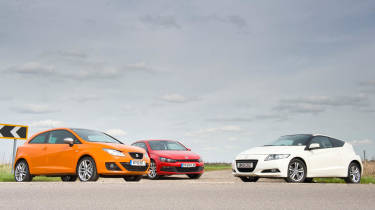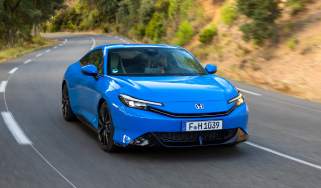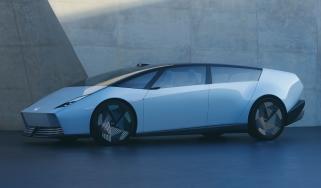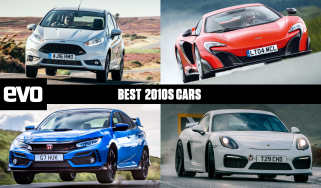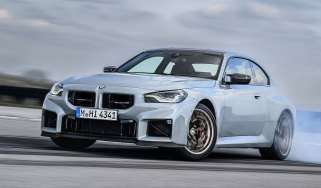Honda CR-Z v Seat Ibiza FR TDI v Volkswagen Scirocco 1.4 TSI 160
Honda's new CR-Z is the world's first hybrid with a sporting edge. But is it as much fun as the diesel and petrol alternatives? And just how green is it when you drive it like a sports car? We find out
Hybrids. The word is enough to send many of us to the nearest patch of sand in which to bury our heads. But the eco-pressure is on, and if we are to continue to enjoy our cars they will have to become a whole lot more energy-efficient.
That can mean smaller, lighter, more agile cars, which of course is great news. It can also mean moving the hybrid idea out of the realms of earnest greenness and into the more hedonistic world that most of us inhabit. The carmakers know this; witness the Porsche 918 Spyder, Ferrari 599 Hybrid and Lotus Evora 414E at the recent Geneva show.
Honda got there first though. A decade ago it launched the Insight, an ultra-light coupe with an aluminium structure and a minimal appetite. It was hardly rapid but was curiously engaging to drive (Harrison Metcalfe of this parish recently added one to his ample fleet). Other Honda hybrids, including the latest Insight, have been less exciting, but now there’s the new CR-Z, and the angle changes significantly.
Honda’s, and the world’s, first production hybrid with a deliberately sporting bent takes its visual inspiration from the original CRX coupe of the 1980s. So it’s a low, fastback shape with a chopped-off tail and a rear window split between the vertical and the near-horizontal. Its engine is a modest 1.4-litre unit, but its efforts are boosted by an electric motor between the engine and the gearbox. Total peak power is 122bhp and while the motor’s 14bhp contribution doesn’t sound much, look at it in torque terms (58lb ft, to add to the engine’s 107lb ft) and it starts to make sense. Especially with 128lb ft at just 1500rpm.
This powertrain is similar to that of the current Insight but recalibrated for the CR-Z’s revised role as automotive entertainer. The platform and suspension are Insight/Jazz-related, too, but wider in the track, shorter in the wheelbase and tauter in feel. The shortness means the CR-Z is a two-plus-two at best. The lithium-ion battery pack lives under the boot floor to keep the centre of gravity low.
In theory, the CR-Z offers fantastically frugal motoring without making you suffer for your greenness. Official figures suggest 56.4mpg is possible on the combined test cycle, and a 117g/km CO2 figure ensures low road tax. As a hybrid, the CR-Z also avoids the London congestion charge. All this comes at prices starting at £16,999 for the S model, rising to £17,999 for the Sport and peaking at £19,999 for the top-spec GT version tested here.
However, there are other routes to frugal entertainment. We’ve chosen two: a new 2-litre, 141bhp, diesel-powered version of SEAT’s Ibiza FR, the sub-Cupra sub-brand whose letters stand for Formula Racing, and a 1.4-litre Volkswagen Scirocco that uses both turbocharging and supercharging to achieve a rousing 158bhp. All three cars major on a low-speed torque-rush while touting various fuel-efficiency credentials. For the £16,430 SEAT it’s a diesel’s high thermal efficiency, allowing an official 61.4 ‘combined’ mpg and 123g/km (diesel produces more CO2 per volume unit burnt than petrol does), while for the £20,660 Volkswagen it’s the use of forced induction on a downsized engine resulting in official figures of 42.8mpg and 154g/km.
That’s the theory. To uncover the reality, we’re taking all three cars on three different routes to test their thirst and their ability to keep us interested while doing their frugal thing. First up, a properly spirited blast on our favourite road type, represented here by the Bedfordshire/Cambridgeshire B660. Next, a dual-carriageway cruise on the A1, A1(M) and A14. Finally, a crawl through Cambridge’s rush-hour traffic.Task one: the B-road blast
Do the best bit first. That’s how to get under the skin of a group of cars quickly. But it’s the first impressions that set the tone even before a wheel has rotated. We’d feared that the spirit of the CR-Z concept had been diluted by the production reality, but in fact in the metal the CR-Z looks convincingly like the CRX remake its maker claims it to be. The profile is wedgier than probably any other new car on sale today, and such is the drama that you don’t immediately notice how unfashionably small are the 16in alloys (17in wheels of a similar design are an option).
Our other coupe, the Scirocco, is more familiar and less dramatic, but again it has concept-car roots of which only the IROC show car’s hefty front air intake didn’t make production. First thoughts on the latest Ibiza’s three-door SC version were of an almost-coupé arguably racier than the Scirocco, but seen here in the bright daylight it looks more the almost-supermini it is. The bright orange metallic paint revs it up, of course, as do the fake brake-cooling vents in the front valance, but the small rear discs look comically lost behind the skeletal 17in wheels. These wear Bridgestone RE050A tyres, a rubber choice shared by all three cars.
Our first, pre-group-test CR-Z encounter was with its hybrid system set, via a button to the right of the instruments, to Econ mode. It was enough to put you off the whole idea: the throttle response redefined mushiness, the performance felt flat, almost nothing happened when a downshift blip was attempted, driving was a chore. There was some amusement to be had from trying to beat the economy score of the previous journey, recorded on bar graphs, but otherwise this was a vision of a bleak future.
Penury served, time to set off on the B-road route. Sport is selected for this section, and the CR-Z becomes an entirely different car. Now attempts at a quick getaway are boosted by a keen surge of torque as the electric motor does what it does best, providing maximum twist action from very low speeds. Another bar graph shows the extent of the motor’s assistance via increments spreading rightwards from a centre point, while throttling-off or braking sends the increments leftwards as the battery charge is regenerated.
In Sport, the CR-Z feels mildly supercharged. An exhaust note of surprising rortiness adds to the keenness; this is hardly a quick car but it’s energetic enough to entertain. Sport also reminds you of your hedonism by making red the solar-eclipse glow that emerges from behind the digital speedometer and fades into the tachometer. In the other modes the glow is green if you’re good, morphing via turquoise to blue as your right foot grows heavier.
Through fast bends, tighter twists and along short straights, the CR-Z is proving quite good fun. Its six-speed gearbox has short, precise throws, its brakes prove remarkably progressive given the need for electronics to smooth the transition from regenerative braking to actual, physical, disc-and-pad retardation, and the future is looking a whole lot brighter. Trouble is, the SEAT has left the Honda for dead.
The way the Ibiza rushes forward with a mere whiff of accelerator, and sustains the surge with near-linearity up to the 5000-or-so rpm beyond which diesel fuel just can’t combust quickly enough, feels refreshingly natural after the Honda’s brand of digital enhancement. The Ibiza FR is the smallest car in the Volkswagen group to have this 2-litre, 16-valve turbodiesel with its whopping 236lb ft of torque, a figure getting on for double the Honda’s. So of course it squirts past slower traffic with ease and minimal turbo lag, and it even sounds quite crisp in the process. This is a diesel with a voice. The six-speed shift lacks the crispness of the Honda’s, but given the energy on offer it’s a forgiveable failing.
And the Scirocco? Here is supercharging of the genuine sort, fading out around 3000rpm as the turbocharger takes over: low-speed lag and high-speed inefficiency both banished in a seamless transition. But there’s something curiously unexciting about the power delivery, which is too even and lacks the rush of enthusiasm a pleasurable engine should have. This is strange. The first version of this clever and complex engine gave 168bhp in a Mk5 Golf GT, and its broadband energy was a revelation. In this one, 10bhp down and doubtless honed to yet tighter emissions purity, the fire has gone out. The Scirocco is quicker than the CR-Z, of course, but it doesn’t make you feel any better.
What the Scirocco does have is the purest, tidiest handling. It goes exactly where you point it, the steering weight is just right, you can trim the cornering line on the throttle, and all three modes of the adjustable damping do what they should. Sport is too firm for most British backroads, giving needlessly choppy progress, while Comfort is just a touch too loose when pressing on. Most of the time Normal is best; no surprise there. Discreet competence is the Scirocco’s theme.
By contrast the CR-Z is a voyage of dynamic discovery. Given that the chief chassis engineer cites the Lotus Elise as the inspiration here, anticipation is keen. So it’s strange that the steering has a stodgy, springy feel around the centre and, in Sport mode, an excess of artificial weight. Equally off-putting at first is the way the Honda squirms its tail as you change direction at speed, making it hard to place, but once settled into a bend and under power it tautens nicely. Understeer is minimal, but so is throttle-adjustability.
The SEAT is quite different from the two coupes. Here, the steering feels initially light and loose but sharpens satisfyingly under cornering load, a load that sees the tail readily trimmable with your accelerator foot and which gives the impression of a car pivoting around its front wheels. The XDS system, effectively a brake-controlled virtual LSD, helps here.
All told, the Ibiza is much the most entertaining on a twisting road. It lets you balance the forces with the greatest subtlety, and it also copes with bumps and undulations that have the Honda on the bumpstops. That’s quite something for a sporting SEAT.
Fuel score: Honda 34.5mpg, SEAT 30.8mpg, Volkswagen 26.9mpg
Task two: the cruise
Time to switch the CR-Z to Normal mode, cutting down on the availability of electric power in the interest of economy. That said, the motor still chips in for a determined haul up a long hill, although its efforts fade after a few seconds in order to maintain some battery charge. On that basis, the claimed 9.9sec 0-62mph time is unlikely to be immediately repeatable. (For the record, the Scirocco dispatches that sprint in 8.0sec, the Seat in 8.2.)
All three cruise quietly, but after a time you might find the CR-Z’s seat gives you backache, negating the good feeling you get from the low-set dashboard and adding to the annoyance of the bar across the rear window. Discovering what’s following you isn’t easy.
By contrast, the SEAT has an oddly high-set facia which gives the FR a lofty feel at odds with its sporting demeanour. The greatest acreage of hard plastics is to be found here, as befits the car with the lowest price, but it also has the greatest rear seat space. As for the Scirocco, it’s the most expensive and feels it.Fuel score: Honda 43.5mpg, SEAT 43.2mpg, Volkswagen 33.9mpg
Task three: the urban crawl
Back to Econ mode for the Honda as we trickle from traffic light to traffic light. This is a much harsher test than the official urban cycle, with lots of idling and some quick squirts as gaps open. Except the Honda doesn’t idle: its engine stops when the car stops, sometimes even fractionally before. If you’ve shifted to neutral it doesn’t restart until you move the gear lever, unlike most other stop-start systems, which fire up as you depress the clutch. The Honda can play this last-chance game because its electric motor restarts the engine more quickly and smoothly than a regular starter motor, and then helps with the getaway. The technology clearly works, too, because on this test the CR-Z used around half the fuel sipped by the SEAT and about a third of that consumed by the Scirocco.
Fuel score: Honda 29.2mpg, SEAT 19.5mpg, Volkswagen 13.3mpg
The verdict
Hybrids are a great idea in theory, but received wisdom is that the advantages evaporate when a car is driven with verve or pounded up a motorway, conditions which favour a good diesel instead. The CR-Z proves otherwise, virtually matching the Ibiza on the motorway and proving significantly more economical elsewhere. The Scirocco is almost profligate by comparison, yet is little quicker than the SEAT and rather less entertaining to drive.
Best to drive, and best value, is the Ibiza. But if you spend more time in slow traffic than you’d like, the Honda will save you significant fuel costs while still being an engaging companion. As the first properly sporting hybrid, it works rather well. Surprised? So are we.
